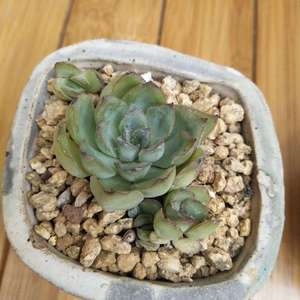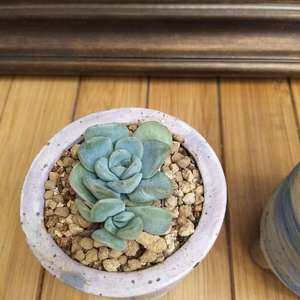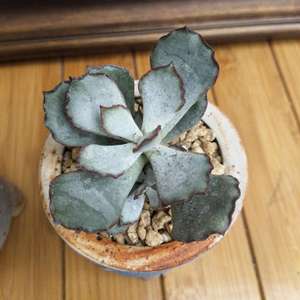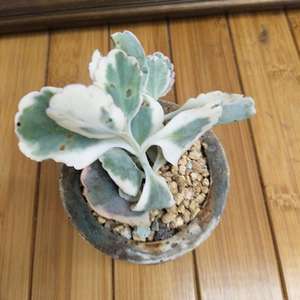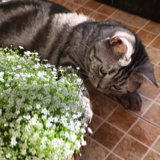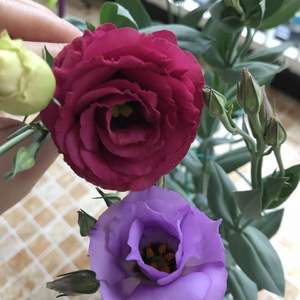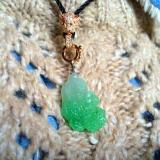辣木姐--璐颖
2018年08月16日

我新添加了一棵“劳尔2018-8-16上盆(AK多肉)¥2元入”到我的“花园”


0
0
辣木姐--璐颖:@五花肉jia鱼 买几颗玩玩,过几天云南大大家的肉到货都是巨无霸
五花肉jia鱼:这家也光顾了
文章
Miss Chen
2018年07月31日

Description: This plant is a winter or spring annual that becomes 4-16" tall, usually forming a tuft of leafy stems that are ascending to sprawling. These stems are branched at the base near the crown of the plant, otherwise they are unbranched. Individual stems are light green, terete, and glandular-hairy. Pairs of opposite leaves occur along these stems (typically at intervals of 1-2½"). These leaves are ¾-2" long, 5-9 mm. across, and elliptic, oblong-lanceolate, or oblong-oblanceolate in shape. The leaf margins are smooth (entire) and slightly ciliate. The leaf surfaces are medium green and either sparsely short-pubescent or hairless. Each leaf has a prominent central vein.
The upper stems terminate in either cymes or compound cymes of flowers (usually the latter); these cymes are dichotomously branched and variable in size. Each terminal branch of the inflorescence typically has 3 flowers with divergent slender pedicels up to 1¼" long. While the flower buds are nodding, the flowers are more erect. Similar to the stems, the branches and pedicels of each inflorescence are light green, terete, and glandular-pubescent. At the base of each pair of branches in an inflorescence, there is a pair of leafy bracts up to ¾" and 5 mm. across. These bracts are lanceolate in shape and they lack membranous margins. The flowers are up to ¼" across while they are in bloom. Each flower has 5 white petals with notched tips, 5 green sepals, an ovary with 5 styles, and 10 stamens (usually). The sepals are lanceolate in shape with membranous margins and short-pubescent; they are about 3-5 mm. long. The petals are the same length or a little longer than the sepals. The blooming period occurs from mid-spring to early summer, lasting about 1 month. Usually, only a few flowers are in bloom at the same time. Sometimes cleistogamous flowers that fail to open are produced.Distribution Map Afterwards, the flowers are replaced by cylindrical seed capsules that become 8-12 mm. long at maturity. Like the flowerbuds, they tend to nod downward. Mature seed capsules are membranous, light tan, longitudinally veined, and often slightly curved; they are more than twice as long as the sepals. Each seed capsule has an open rim at its apex with 10 tiny teeth. Each seed capsule contains several tiny seeds about 0.5 mm. in length. The seeds are obovoid, somewhat flattened, brownish, and minutely tuberculate (warty). The root system system consists of a shallow spreading taproot.
Cultivation: The preference is full sun to light shade and moist conditions. Nodding Chickweed is not particular about soil. Most growth and development occurs during the spring when the weather is cool and moist, after which the foliage dies down.
Range & Habitat: The native Nodding Chickweed is occasional to locally common in most areas of Illinois. Habitats include floodplain woodlands, streambanks in wooded areas, ravines and ledges along streams, gravel bars along rivers, weedy meadows, nursery plots, and moist waste areas. Nodding Chickweed occurs in both natural areas and human-mediated environments. In natural areas, it tends to occur in places where there is some disturbance by the action of water (e.g., soil erosion or deposits of gravel).
Faunal Associations: The flowers are cross-pollinated by honeybees, Halictid bees (Halictus spp., Lasioglossum spp.), small butterflies, Syrphid flies, and other flies (Robertson, 1929). Both nectar and pollen are available as floral rewards. The caterpillars and cutworms of various moths are known to feed on chickweeds (Stellaria spp., Cerastium spp.). These moth species include Haematopis grataria (Chickweed Geometer), Lobocleta ossularia (Drab Brown Wave), Agrotis venerabilis (Venerable Dart), Hyles lineata (White-Lined Sphinx), Feltia jaculifera (Dingy Cutworm), Xestia badinodis (Spot-Sided Cutworm), and Xanthorhoe ferrugata (Red Twin-Spot). Vertebrate animals also feed on these plants to some extent. Various sparrows and other granivorous songbirds eat the seeds, while deer, rabbits, and domesticated farm animals (cattle, horses, sheep, & pigs) occasionally browse on the foliage.
Photographic Location: A gravel bar along a river in a wooded area of Pine Hills State Nature Preserve in west-central Indiana.
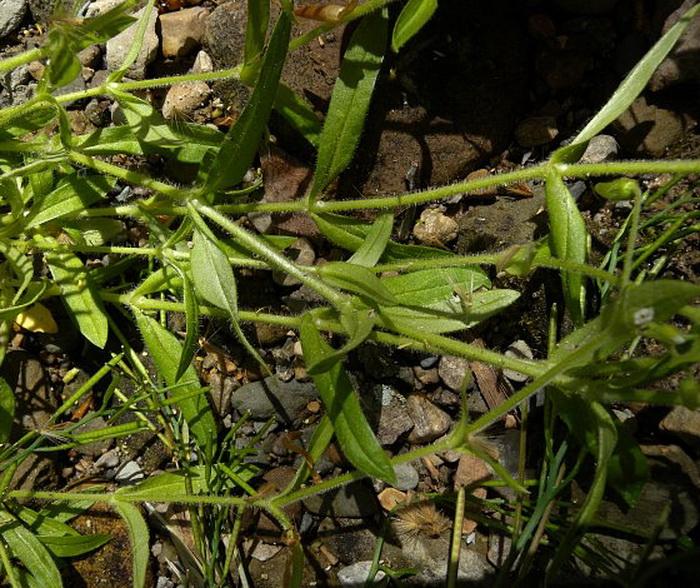
Comments: Notwithstanding its weedy appearance and habits, this is one of the native chickweeds in Illinois. It is a rather floppy plant with small white flowers. Nodding Chickweed can be distinguished from other chickweeds (Stellaria spp., Cerastium spp.) by the shape of its leaves, diffuse inflorescence, and structure of its flowers. In particular, the pedicels of its flowers are rather long (1" in length or more) and divergent, while its flowerbuds and seed capsules nod downward. Among the Mouse-Eared Chickweeds (Cerastium spp.), Nodding Chickweed has rather long and narrow leaves. Some authorities consider the more western Cerastium brachypodum to be a variety of Nodding Chickweed, or Cerastium nutans obtectum. This latter species (or variety) tends to have more hairy leaves and its pedicels are shorter (less than 1" in length).
The upper stems terminate in either cymes or compound cymes of flowers (usually the latter); these cymes are dichotomously branched and variable in size. Each terminal branch of the inflorescence typically has 3 flowers with divergent slender pedicels up to 1¼" long. While the flower buds are nodding, the flowers are more erect. Similar to the stems, the branches and pedicels of each inflorescence are light green, terete, and glandular-pubescent. At the base of each pair of branches in an inflorescence, there is a pair of leafy bracts up to ¾" and 5 mm. across. These bracts are lanceolate in shape and they lack membranous margins. The flowers are up to ¼" across while they are in bloom. Each flower has 5 white petals with notched tips, 5 green sepals, an ovary with 5 styles, and 10 stamens (usually). The sepals are lanceolate in shape with membranous margins and short-pubescent; they are about 3-5 mm. long. The petals are the same length or a little longer than the sepals. The blooming period occurs from mid-spring to early summer, lasting about 1 month. Usually, only a few flowers are in bloom at the same time. Sometimes cleistogamous flowers that fail to open are produced.Distribution Map Afterwards, the flowers are replaced by cylindrical seed capsules that become 8-12 mm. long at maturity. Like the flowerbuds, they tend to nod downward. Mature seed capsules are membranous, light tan, longitudinally veined, and often slightly curved; they are more than twice as long as the sepals. Each seed capsule has an open rim at its apex with 10 tiny teeth. Each seed capsule contains several tiny seeds about 0.5 mm. in length. The seeds are obovoid, somewhat flattened, brownish, and minutely tuberculate (warty). The root system system consists of a shallow spreading taproot.
Cultivation: The preference is full sun to light shade and moist conditions. Nodding Chickweed is not particular about soil. Most growth and development occurs during the spring when the weather is cool and moist, after which the foliage dies down.
Range & Habitat: The native Nodding Chickweed is occasional to locally common in most areas of Illinois. Habitats include floodplain woodlands, streambanks in wooded areas, ravines and ledges along streams, gravel bars along rivers, weedy meadows, nursery plots, and moist waste areas. Nodding Chickweed occurs in both natural areas and human-mediated environments. In natural areas, it tends to occur in places where there is some disturbance by the action of water (e.g., soil erosion or deposits of gravel).
Faunal Associations: The flowers are cross-pollinated by honeybees, Halictid bees (Halictus spp., Lasioglossum spp.), small butterflies, Syrphid flies, and other flies (Robertson, 1929). Both nectar and pollen are available as floral rewards. The caterpillars and cutworms of various moths are known to feed on chickweeds (Stellaria spp., Cerastium spp.). These moth species include Haematopis grataria (Chickweed Geometer), Lobocleta ossularia (Drab Brown Wave), Agrotis venerabilis (Venerable Dart), Hyles lineata (White-Lined Sphinx), Feltia jaculifera (Dingy Cutworm), Xestia badinodis (Spot-Sided Cutworm), and Xanthorhoe ferrugata (Red Twin-Spot). Vertebrate animals also feed on these plants to some extent. Various sparrows and other granivorous songbirds eat the seeds, while deer, rabbits, and domesticated farm animals (cattle, horses, sheep, & pigs) occasionally browse on the foliage.
Photographic Location: A gravel bar along a river in a wooded area of Pine Hills State Nature Preserve in west-central Indiana.

Comments: Notwithstanding its weedy appearance and habits, this is one of the native chickweeds in Illinois. It is a rather floppy plant with small white flowers. Nodding Chickweed can be distinguished from other chickweeds (Stellaria spp., Cerastium spp.) by the shape of its leaves, diffuse inflorescence, and structure of its flowers. In particular, the pedicels of its flowers are rather long (1" in length or more) and divergent, while its flowerbuds and seed capsules nod downward. Among the Mouse-Eared Chickweeds (Cerastium spp.), Nodding Chickweed has rather long and narrow leaves. Some authorities consider the more western Cerastium brachypodum to be a variety of Nodding Chickweed, or Cerastium nutans obtectum. This latter species (or variety) tends to have more hairy leaves and its pedicels are shorter (less than 1" in length).
0
0
文章
Miss Chen
2018年07月30日

Description: This plant is a winter or spring annual about 4-16" tall that sometimes branches from the base, forming a tuft of leafy stems. Each erect to ascending stem is light green to pale purplish green, terete, and evenly glandular-pubescent. Several pairs of opposite leaves occur along each stem; sometimes tufts of smaller leaves develop from the axils of the lower opposite leaves. These leaves are up to 1" long and 1/5" (5 mm.) across; they are linear, linear-oblong, or oblong, and sessile against their stems. Each leaf is hairless on the upper surface with a single prominent vein; the lower surface is also hairless, except for some glandular hairs along the central vein. The leaf margins are smooth and ciliate.
Each stem terminates in a corymb (flat-headed cluster) or compound corymb of flowers. The peduncle of each corymb is similar to the stem, except that it has a pair of leafy bracts at its base; it can be several inches long. Compound corymbs have branched ascending peduncles. Each flower is up to ¼" across; it has 5 white petals, 5 green sepals, 10 stamens, and 3 tiny white styles at the apex of the light green ovary. The petals are cleft at their tips, while the sepals are glandular-pubescent. The pedicel of each flower is up to ½" long and glandular-pubescent. The leafy bracts are linear-lanceolate to ovate, glandular-pubescent on their undersides, and slightly membranous along their margins at maturity; they are smaller in size than the leaves (½" long or less). The blooming period occurs during the late spring and lasts about 3 weeks. There is no noticeable floral scent. Each flower is replaced by a cylindrical seed capsule that is up to 10 mm. (3/8") long. At maturity, this seed capsule becomes membranous and open at its apex; there are 6 small teeth along its upper rim. There are numerous small seeds within each capsule; each seed is pale brown, minutely warty, ovoid-obovoid in shape, and somewhat flattened. The root system consists of a slender branching taproot with fine fibrous roots. This plant spreads by reseeding itself and occasionally forms colonies.

Cultivation: Typical growing conditions consist of full sunlight and average levels of moisture. Three-styled Chickweed adapts readily to loam or clay-loam soil; sandy or gravelly soil may be tolerated as well. Because this chickweed is taller and more erect than most, regular mowing may inhibit its spread.
Range & Habitat: The adventive Three-Styled Chickweed is a rare weed in Illinois; it has been observed in only a few counties of south-central and east-central Illinois (see Distribution Map). This species is native to southern Europe and parts of Asia. The earliest collection of this species in the United States occurred in the state of Washington during the 1960's. Since that time, it has been observed in several other states (both eastern & western) and appears to be spreading. Habitats include disturbed areas with low grassy or weedy vegetation and the upper slopes of ditches. Recent construction activity mayClose-up of Flower have introduced this species to Champaign County in Illinois.
Faunal Associations: This information applies to chickweeds, both native and introduced, that are typically found in sunny meadows and similar habitats. The nectar and pollen of the flowers attract small bees (Halictid & others) and flies (Syrphid & others). The caterpillars of the moths Agrostis venerabilis (Venerable Dart), Haematopis grataria (Chickweed Geometer), and Lobocleta ossularia (Drab Brown Wave) feed on chickweeds. Among vertebrate animals, the seeds are a source of food for the Mourning Dove and various sparrows, while the foliage is occasionally eaten by the Cottontail Rabbit.
Photographic Location: The upper slope of a drainage ditch in Urbana, Illinois. If the photograph of the flower close-up is examined closely, it is possible to see the 3 tiny white styles; they are surrounded by the yellow anthers of the stamens.

Comments: Among Cerastium spp. (Mouse-Eared Chickweeds), this chickweed is highly unusual because its flowers have 3 styles, rather than 5 styles. This characteristic is more typical of Stellaria spp. (Chickweeds). However, other characteristics of its flowers (e.g., the presence of 10 stamens & the shape of its petals) and the even pubescence of its stems are more typical of the Mouse-Eared Chickweeds. Three-Styled Chickweed is a little taller than most of these species and its leaves are more slender. Otherwise, it is rather ordinary looking. Another common name is Doubtful Chickweed, which is derived from the scientific name.
Each stem terminates in a corymb (flat-headed cluster) or compound corymb of flowers. The peduncle of each corymb is similar to the stem, except that it has a pair of leafy bracts at its base; it can be several inches long. Compound corymbs have branched ascending peduncles. Each flower is up to ¼" across; it has 5 white petals, 5 green sepals, 10 stamens, and 3 tiny white styles at the apex of the light green ovary. The petals are cleft at their tips, while the sepals are glandular-pubescent. The pedicel of each flower is up to ½" long and glandular-pubescent. The leafy bracts are linear-lanceolate to ovate, glandular-pubescent on their undersides, and slightly membranous along their margins at maturity; they are smaller in size than the leaves (½" long or less). The blooming period occurs during the late spring and lasts about 3 weeks. There is no noticeable floral scent. Each flower is replaced by a cylindrical seed capsule that is up to 10 mm. (3/8") long. At maturity, this seed capsule becomes membranous and open at its apex; there are 6 small teeth along its upper rim. There are numerous small seeds within each capsule; each seed is pale brown, minutely warty, ovoid-obovoid in shape, and somewhat flattened. The root system consists of a slender branching taproot with fine fibrous roots. This plant spreads by reseeding itself and occasionally forms colonies.

Cultivation: Typical growing conditions consist of full sunlight and average levels of moisture. Three-styled Chickweed adapts readily to loam or clay-loam soil; sandy or gravelly soil may be tolerated as well. Because this chickweed is taller and more erect than most, regular mowing may inhibit its spread.
Range & Habitat: The adventive Three-Styled Chickweed is a rare weed in Illinois; it has been observed in only a few counties of south-central and east-central Illinois (see Distribution Map). This species is native to southern Europe and parts of Asia. The earliest collection of this species in the United States occurred in the state of Washington during the 1960's. Since that time, it has been observed in several other states (both eastern & western) and appears to be spreading. Habitats include disturbed areas with low grassy or weedy vegetation and the upper slopes of ditches. Recent construction activity mayClose-up of Flower have introduced this species to Champaign County in Illinois.
Faunal Associations: This information applies to chickweeds, both native and introduced, that are typically found in sunny meadows and similar habitats. The nectar and pollen of the flowers attract small bees (Halictid & others) and flies (Syrphid & others). The caterpillars of the moths Agrostis venerabilis (Venerable Dart), Haematopis grataria (Chickweed Geometer), and Lobocleta ossularia (Drab Brown Wave) feed on chickweeds. Among vertebrate animals, the seeds are a source of food for the Mourning Dove and various sparrows, while the foliage is occasionally eaten by the Cottontail Rabbit.
Photographic Location: The upper slope of a drainage ditch in Urbana, Illinois. If the photograph of the flower close-up is examined closely, it is possible to see the 3 tiny white styles; they are surrounded by the yellow anthers of the stamens.

Comments: Among Cerastium spp. (Mouse-Eared Chickweeds), this chickweed is highly unusual because its flowers have 3 styles, rather than 5 styles. This characteristic is more typical of Stellaria spp. (Chickweeds). However, other characteristics of its flowers (e.g., the presence of 10 stamens & the shape of its petals) and the even pubescence of its stems are more typical of the Mouse-Eared Chickweeds. Three-Styled Chickweed is a little taller than most of these species and its leaves are more slender. Otherwise, it is rather ordinary looking. Another common name is Doubtful Chickweed, which is derived from the scientific name.
0
0
文章
Miss Chen
2018年06月24日

Description: This herbaceous perennial plant has branching leafy stems that are 4–16" long. These stems have a tendency to sprawl and cling to adjacent vegetation; they are light green to light greenish purple, and 4-angled. The stems have short stiff hairs along their angles, otherwise they are hairless. Whorls of 4 spreading leaves (never 5–6 leaves) occur at intervals along these stems; these leaves are sessile, or nearly so. Individual leaves are 6-19 mm. (¼–¾") long, narrowly elliptic or narrowly elliptic-oblanceolate in shape, and toothless along their margins. The leaf tips are rounded. The leaf surfaces are yellowish green to medium green; short stiff hairs occur along the margins of the leaves and along the underside of their central veins. The short stiff hairs of both the stems and leaves can cling to neighboring vegetation or objects. Each leaf has a prominent central vein. The stems often terminate in small clusters of 2-3 flowers; either solitary or small clusters of 2-3 flowers are also produced from the axils of leaves.
Each flower is about 1.5–2 mm. across, consisting of a white corolla with 3 lobes, 3 stamens, 2 styles that are joined together at the base, and 2 spheroid light green ovaries that are connected together. The lobes of the corolla are oval-ovate in shape. The pedicels of the flowers are usually longer than the corresponding leaves. These pedicels are light green to light purplish green and usually more or less curved; they have short stiff hairs that can cling to adjacent vegetation or objects. The pedicels become even longer as the ovaries mature. The blooming period occurs from mid-summer to late summer for about 1½ months. Only a few flowers are in bloom at the same time. Afterwards, the maturing paired ovaries expand in size, changing color from light green (or light purple) to brown (or black) at maturity. These ovaries are hairless and single-seeded; they eventually split apart. The small seeds are spheroid in shape and partially hollow inside; they are capable of floating on water and being distributed by it. The root system is shallow and fibrous.
Cultivation: The preference is full or partial sun, shallow water or wet conditions, a substrate containing some sand or organic material, and a relatively cool climate.

Range & Habitat: Small Bedstraw (Galium trifidum) is uncommon in Illinois, occurring in the NE section of the state, and a central section of the state along or near the Illinois River (see Distribution Map). Illinois lies along the southern range-limit of this species. It is more widely distributed in North America further to the north and it also occurs in Eurasia. Habitats include edges of sphagnum bogs, cattail marshes, low sandy areas along rivers, and northern swamps. In Illinois, Small Bedstraw is found in high quality wetlands in natural areas.
Faunal Associations: Various insects feed on foliage or sap of bedstraws (Galium spp.). These insect feeders include the larvae of a leaf-mining fly (Galiomyza galiivora), larvae of the Bedstraw Midge (Dasineura americana), larvae of an introduced sawfly (Halidamia affinis), and larvae of the Galium Sphinx (Hyles gallii); see Spencer & Steyskal, 1986; Felt, 1917; Smith, 2006; Wagner, 2005). Other insects that have been observed to feed on bedstraws include aphids, the larvae of Geometer moths, plant bugs (Miridae), stinkbugs (Pentatomidae), and ebony bugs (Thyreocoridae). The nectar and pollen of the flowers of these plants attract primarily small bees and flies (Robertson, 1929). Bedstraws that inhabit wetlands are a minor source of food to Muskrats (Hamerstrom & Blake, 1939).

Photographic Location: A cattail marsh near Volo Bog in Lake County, Illinois.
Comments: This bedstraw is quite small in size and rather inconspicuous. It can be distinguished from other bedstraw species (Galium spp.) primarily by the 3-lobed corollas of its flowers, the whorls of 4 leaves along its stems, the long curved pedicels of its flowers or fruits, and its strong preference for wetland habitats. The only other bedstraw species that produces 3-lobed flowers in Illinois, Stiff Bedstraw (Galium tinctorium), is a little larger in size overall. Unlike Small Bedstraw (Galium trifidum), Stiff Bedstraw sometimes has whorls of 5-6 leaves along its stems and sometimes it also produces 4-lobed flowers (even on the same plant). The pedicels of Stiff Bedstraw with maturing fruits are shorter in length and more straight than those of Small Bedstraw, and they are hairless. Another similar bedstraw, Wild Madder (Galium obtusum), is also slightly larger in size than Small Bedstraw. Wild Madder always produces flowers with 4-lobed corollas; it has whorls of 4-6 leaves along its stems, and its stems lack the short stiff hairs that are found on the stems of Small Bedstraw and Stiff Bedstraw. Unlike many other bedstraws, all three of these species have hairless ovaries/fruits. Another common name of Galium trifidum is Three-petaled Bedstraw.
Each flower is about 1.5–2 mm. across, consisting of a white corolla with 3 lobes, 3 stamens, 2 styles that are joined together at the base, and 2 spheroid light green ovaries that are connected together. The lobes of the corolla are oval-ovate in shape. The pedicels of the flowers are usually longer than the corresponding leaves. These pedicels are light green to light purplish green and usually more or less curved; they have short stiff hairs that can cling to adjacent vegetation or objects. The pedicels become even longer as the ovaries mature. The blooming period occurs from mid-summer to late summer for about 1½ months. Only a few flowers are in bloom at the same time. Afterwards, the maturing paired ovaries expand in size, changing color from light green (or light purple) to brown (or black) at maturity. These ovaries are hairless and single-seeded; they eventually split apart. The small seeds are spheroid in shape and partially hollow inside; they are capable of floating on water and being distributed by it. The root system is shallow and fibrous.
Cultivation: The preference is full or partial sun, shallow water or wet conditions, a substrate containing some sand or organic material, and a relatively cool climate.

Range & Habitat: Small Bedstraw (Galium trifidum) is uncommon in Illinois, occurring in the NE section of the state, and a central section of the state along or near the Illinois River (see Distribution Map). Illinois lies along the southern range-limit of this species. It is more widely distributed in North America further to the north and it also occurs in Eurasia. Habitats include edges of sphagnum bogs, cattail marshes, low sandy areas along rivers, and northern swamps. In Illinois, Small Bedstraw is found in high quality wetlands in natural areas.
Faunal Associations: Various insects feed on foliage or sap of bedstraws (Galium spp.). These insect feeders include the larvae of a leaf-mining fly (Galiomyza galiivora), larvae of the Bedstraw Midge (Dasineura americana), larvae of an introduced sawfly (Halidamia affinis), and larvae of the Galium Sphinx (Hyles gallii); see Spencer & Steyskal, 1986; Felt, 1917; Smith, 2006; Wagner, 2005). Other insects that have been observed to feed on bedstraws include aphids, the larvae of Geometer moths, plant bugs (Miridae), stinkbugs (Pentatomidae), and ebony bugs (Thyreocoridae). The nectar and pollen of the flowers of these plants attract primarily small bees and flies (Robertson, 1929). Bedstraws that inhabit wetlands are a minor source of food to Muskrats (Hamerstrom & Blake, 1939).

Photographic Location: A cattail marsh near Volo Bog in Lake County, Illinois.
Comments: This bedstraw is quite small in size and rather inconspicuous. It can be distinguished from other bedstraw species (Galium spp.) primarily by the 3-lobed corollas of its flowers, the whorls of 4 leaves along its stems, the long curved pedicels of its flowers or fruits, and its strong preference for wetland habitats. The only other bedstraw species that produces 3-lobed flowers in Illinois, Stiff Bedstraw (Galium tinctorium), is a little larger in size overall. Unlike Small Bedstraw (Galium trifidum), Stiff Bedstraw sometimes has whorls of 5-6 leaves along its stems and sometimes it also produces 4-lobed flowers (even on the same plant). The pedicels of Stiff Bedstraw with maturing fruits are shorter in length and more straight than those of Small Bedstraw, and they are hairless. Another similar bedstraw, Wild Madder (Galium obtusum), is also slightly larger in size than Small Bedstraw. Wild Madder always produces flowers with 4-lobed corollas; it has whorls of 4-6 leaves along its stems, and its stems lack the short stiff hairs that are found on the stems of Small Bedstraw and Stiff Bedstraw. Unlike many other bedstraws, all three of these species have hairless ovaries/fruits. Another common name of Galium trifidum is Three-petaled Bedstraw.
0
0
文章
Miss Chen
2018年06月14日

Description: This wildflower is a biennial that forms a rosette of basal leaves during the first year, followed by a flowering plant about 2-7' tall the following year. The basal leaves are up to 16" long and 6" across, although they are normally closer to about one-half that size. Aside from a tendency to be larger in size, they are similar to the alternate leaves of a flowering plant (as described below). A typical flowering plant is unbranched below and occasionally branched above. The central stem and any lateral stems are light green, terete, and longitudinally furrowed; they are finely hairy above, becoming more glabrous below. Alternate leaves are up to 10" long and 4" across, becoming gradually smaller in size as they ascend the stems. In outline, these leaves are lanceolate-oblong to elliptic-oblong; they are also pinnatifid with several pairs of lanceolate to linear-lanceolate lobes that have spiny tips. The lobes of the alternate leaves usually have smaller secondary lobes or sharp teeth that may also have spiny tips. The spines are golden yellow and up to 1/8" (3 mm.) long. The upper leaf surface is medium to dark green and glabrous to sparsely short-pubescent. The lower leaf surface is usually whitened from a dense coating of short white hairs while young, but it becomes more pale green with age from a thinning of such hairs.

The central stem and any upper stems terminate in either individual flowerheads or open corymbs of 2-5 flowerheads. The peduncles of these flowerhead are 1-6" long, light green (less often pale purple), terete, finely grooved, and finely hairy to nearly glabrous. There is usually a single leafy bract (up to 3" long) at the base of each peduncle and, less often, there may be a whorl of a few leafy bracts (up to 1½" long) underneath the flowerhead. Otherwise, the peduncle is naked. The leafy bracts resemble the alternate leaves, except they are smaller in size and their spiny lobes are more narrow. Each peduncle terminates in a flowerhead that is about 1¼-2" across and similarly in length. At the flattened top of the flowerhead, there is a dense cluster of numerous disk florets; there are no ray florets. The disk florets are perfect and fertile. The corollas of the disk florets are narrowly cylindrical below, becoming slightly wider above with 5 narrow lobes. These corollas vary in color from pink to pinkish purple. The sides of the flowerhead consist of overlapping floral bracts (phyllaries) that are appressed together in several series. These floral bracts are lanceolate to ovate in shape; their tips taper into erect minute spines, or such spines may be absent. The sticky floral bracts have narrow mid-ribs that are pale green, otherwise they are blackish green; appressed woolly hair usually occurs between the floral bracts. The blooming period occurs from mid-summer to early fall, lasting about 1½ months. Afterwards, the ray florets are replaced by small achenes with tufts of white hair. Individual achenes are about 5 mm. long, oblongoid, and dark brown to black with bands of yellow at their upper ends. They are distributed by the wind. The root system consists of a stout taproot.

Cultivation: The preference is full sun, wet to moist conditions, and calcareous sand, although partial sun and other soil types are tolerated. The size of individual plants can be highly variable, depending on moisture level, soil fertility, and competition from other plants.
Range & Habitat: The native Swamp Thistle is occasional in NE Illinois, otherwise it is uncommon or absent elsewhere in the state (see Distribution Map). This plant is more common further to the north. Habitats include wet sand prairies, sandy swamps, marshes, fens, interdunal swales near Lake Michigan, limestone bluffs (where some seepage of ground water occurs), pastures, and abandoned sandy fields. Swamp Thistle is found primarily in sandy wetlands and rocky areas where seepage through limestone occurs. It is perhaps most common in fens.
Faunal Associations: The flowerheads of Swamp Thistle and similar Cirsium spp. (thistles) attract many insects, especially long-tongued bees and butterflies. Typical floral visitors include honeybees, bumblebees, long-horned bees (Melissodes spp.), leaf-cutting bees (Megachile spp.), Cuckoo beesTiger Swallowtail Nectaring at Flowerhead (Triepeolus spp.), Swallowtail butterflies (Papilio spp.), Fritillary butterflies (Speyeria spp.), Painted Lady butterflies (Vanessa spp.), and day-flying moths. Most of these insects suck nectar, although some bees also collect pollen. A long-horned bee, Melissodes desponsa, is an oligolege (specialist pollinator) of thistles. Other insect feed destructively on these plants. Swamp Thistle is the preferred host plant for the caterpillars of an uncommon butterfly, Calephelis mutica (Swamp Metalmark). Other insect feeders of thistles include caterpillars of Vanessa cardui (Painted Lady), caterpillars of Platyptilia carduidactyla (Artichoke Plume Moth) and Papaipema arctivorens (Northern Burdock Borer Moth), the leaf beetle Cassida rubiginosa, stem-boring larvae of Lixus concavus (Rhubarb Weevil), Melanoplus borealis (Northern Grasshopper), Brachycaudus cardui (Thistle Aphid) and Capitophorus elaeagni (Artichoke Aphid), and the treehopper Entylia bactriana. See the Insect Table for a more complete listing of these species. Because Swamp Thistle has some protection from its spines and it occurs in less accessible wetland habitats, it is usually ignored by mammalian herbivores. Some small songbirds, however, eat the seeds of thistles, especially the American Goldfinch. This bird also uses the hair tufts of thistle seeds in the construction of its nests. Another small bird, the Ruby-Throated Hummingbird, occasionally visits the flowerheads of thistles for their nectar.
Photographic Location: A fen in NE Illinois. The photographs were taken by Lisa Culp (Copyright © 2011).
Comments: Swamp Thistle (Cirsium muticum) resembles the more common Pasture Thistle (Cirsium discolor) and other tall-growing thistle species. It can be distinguished from these other species by the lack of significant spines on its floral bracts (phyllaries) and its preference for wetland habitats. While the leaf undersides of Swamp Thistle tend to be somewhat whitened, they are usually less whitened than either the Pasture Thistle or Tall Thistle (Cirsium altissimum). A Eurasian species that has not been found in Illinois, but appears to be spreading in other areas of the United States, is the Marsh Thistle (Cirsium palustre). Like the Swamp Thistle, Marsh Thistle also prefers wetland habitats, but it has smaller flowerheads (1" across or less) and its floral bracts have outward-pointing fine spines. This Eurasian thistle also tends to be somewhat smaller in size than the Swamp Thistle. Another common name of Cirsium muticum is Fen Thistle.

The central stem and any upper stems terminate in either individual flowerheads or open corymbs of 2-5 flowerheads. The peduncles of these flowerhead are 1-6" long, light green (less often pale purple), terete, finely grooved, and finely hairy to nearly glabrous. There is usually a single leafy bract (up to 3" long) at the base of each peduncle and, less often, there may be a whorl of a few leafy bracts (up to 1½" long) underneath the flowerhead. Otherwise, the peduncle is naked. The leafy bracts resemble the alternate leaves, except they are smaller in size and their spiny lobes are more narrow. Each peduncle terminates in a flowerhead that is about 1¼-2" across and similarly in length. At the flattened top of the flowerhead, there is a dense cluster of numerous disk florets; there are no ray florets. The disk florets are perfect and fertile. The corollas of the disk florets are narrowly cylindrical below, becoming slightly wider above with 5 narrow lobes. These corollas vary in color from pink to pinkish purple. The sides of the flowerhead consist of overlapping floral bracts (phyllaries) that are appressed together in several series. These floral bracts are lanceolate to ovate in shape; their tips taper into erect minute spines, or such spines may be absent. The sticky floral bracts have narrow mid-ribs that are pale green, otherwise they are blackish green; appressed woolly hair usually occurs between the floral bracts. The blooming period occurs from mid-summer to early fall, lasting about 1½ months. Afterwards, the ray florets are replaced by small achenes with tufts of white hair. Individual achenes are about 5 mm. long, oblongoid, and dark brown to black with bands of yellow at their upper ends. They are distributed by the wind. The root system consists of a stout taproot.

Cultivation: The preference is full sun, wet to moist conditions, and calcareous sand, although partial sun and other soil types are tolerated. The size of individual plants can be highly variable, depending on moisture level, soil fertility, and competition from other plants.
Range & Habitat: The native Swamp Thistle is occasional in NE Illinois, otherwise it is uncommon or absent elsewhere in the state (see Distribution Map). This plant is more common further to the north. Habitats include wet sand prairies, sandy swamps, marshes, fens, interdunal swales near Lake Michigan, limestone bluffs (where some seepage of ground water occurs), pastures, and abandoned sandy fields. Swamp Thistle is found primarily in sandy wetlands and rocky areas where seepage through limestone occurs. It is perhaps most common in fens.
Faunal Associations: The flowerheads of Swamp Thistle and similar Cirsium spp. (thistles) attract many insects, especially long-tongued bees and butterflies. Typical floral visitors include honeybees, bumblebees, long-horned bees (Melissodes spp.), leaf-cutting bees (Megachile spp.), Cuckoo beesTiger Swallowtail Nectaring at Flowerhead (Triepeolus spp.), Swallowtail butterflies (Papilio spp.), Fritillary butterflies (Speyeria spp.), Painted Lady butterflies (Vanessa spp.), and day-flying moths. Most of these insects suck nectar, although some bees also collect pollen. A long-horned bee, Melissodes desponsa, is an oligolege (specialist pollinator) of thistles. Other insect feed destructively on these plants. Swamp Thistle is the preferred host plant for the caterpillars of an uncommon butterfly, Calephelis mutica (Swamp Metalmark). Other insect feeders of thistles include caterpillars of Vanessa cardui (Painted Lady), caterpillars of Platyptilia carduidactyla (Artichoke Plume Moth) and Papaipema arctivorens (Northern Burdock Borer Moth), the leaf beetle Cassida rubiginosa, stem-boring larvae of Lixus concavus (Rhubarb Weevil), Melanoplus borealis (Northern Grasshopper), Brachycaudus cardui (Thistle Aphid) and Capitophorus elaeagni (Artichoke Aphid), and the treehopper Entylia bactriana. See the Insect Table for a more complete listing of these species. Because Swamp Thistle has some protection from its spines and it occurs in less accessible wetland habitats, it is usually ignored by mammalian herbivores. Some small songbirds, however, eat the seeds of thistles, especially the American Goldfinch. This bird also uses the hair tufts of thistle seeds in the construction of its nests. Another small bird, the Ruby-Throated Hummingbird, occasionally visits the flowerheads of thistles for their nectar.
Photographic Location: A fen in NE Illinois. The photographs were taken by Lisa Culp (Copyright © 2011).
Comments: Swamp Thistle (Cirsium muticum) resembles the more common Pasture Thistle (Cirsium discolor) and other tall-growing thistle species. It can be distinguished from these other species by the lack of significant spines on its floral bracts (phyllaries) and its preference for wetland habitats. While the leaf undersides of Swamp Thistle tend to be somewhat whitened, they are usually less whitened than either the Pasture Thistle or Tall Thistle (Cirsium altissimum). A Eurasian species that has not been found in Illinois, but appears to be spreading in other areas of the United States, is the Marsh Thistle (Cirsium palustre). Like the Swamp Thistle, Marsh Thistle also prefers wetland habitats, but it has smaller flowerheads (1" across or less) and its floral bracts have outward-pointing fine spines. This Eurasian thistle also tends to be somewhat smaller in size than the Swamp Thistle. Another common name of Cirsium muticum is Fen Thistle.
0
0




